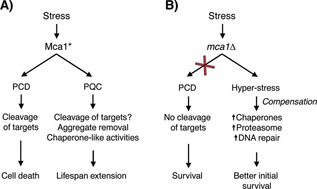Figure 3.

The dual role of Mca1 in cell death and cell survival. The figure schematically describes two different scenarios that could explain the increased survival of Mca1‐deficient cells observed upon H2O2 treatment and aging. A: Reports have shown that Mca1 is processed, and presumably activated (active Mca1 denoted as Mca1*), upon H2O2 exposure, and that this in turn causes downstream effects leading to cellular death. The same processing and activation of Mca1 is seen in replicatively aged cells, where Mca1 has a beneficial role in protein quality control and lifespan extension. B: Deletion of Mca1 results in a better survival after H2O2 exposure and in stationary phase. This finding can be explained by Mca1 acting as a killer protein and by the observation that the removal of such a protein enhances survival. Another explanation could be that the removal of Mca1, acting as an important player in cytoprotection, causes upregulation of compensatory stress resistance factors, including several chaperones, hence indirectly enhancing survival (compensation).
